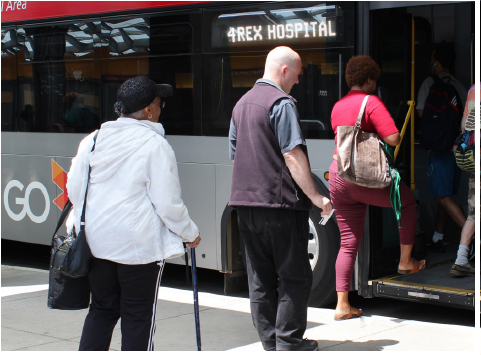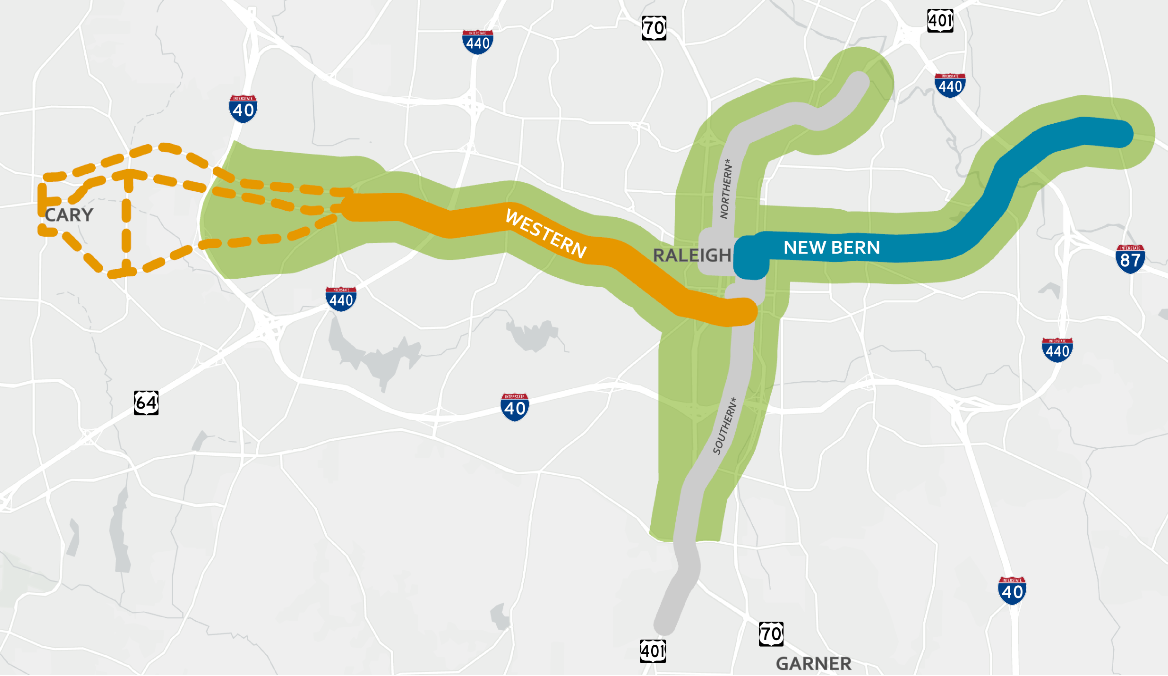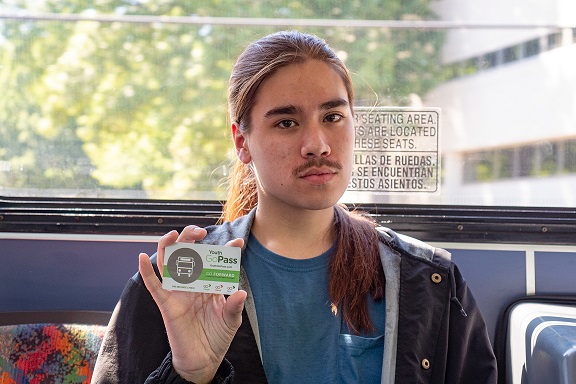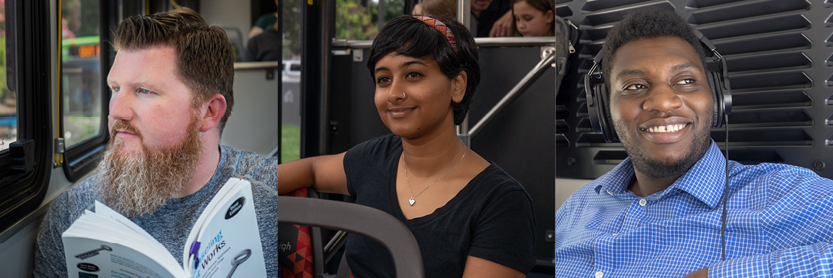
(DEC. 17, 2019) -- Being able to combine two new Wake County bus routes into a workable, relaxing commute between his Raleigh home and his job in Morrisville has made Colby Davis one happy Triangle resident.
In August, GoTriangle’s new North Raleigh Express, which runs along I-540 from Triangle Town Center to the Regional Transit Center, and its new Route 310, which runs between the RTC and Wake Tech RTP near Perimeter Park, started on the same day.
Davis was on the inaugural runs and has been taking advantage of relaxing on the bus three or four days a week since.
“I prefer the bus because I’m not contributing to traffic on 540, which is wonderful, and I’m not contributing to carbon emissions, which is wonderful,” says Davis, an information technology worker at IQVIA. “And it’s a lot less stressful. I can zone out and stare at my phone and scroll.”
The two new GoTriangle routes are among numerous transit improvements that have rolled out in calendar year 2019 as part of the Wake Transit Plan. Wake County voters approved the 10-year plan and a half-cent transit-designated tax to pay for it in November 2016. Its goals are to connect the region, connect all Wake County communities, provide frequent and reliable urban mobility and enhance access to transit.
Here’s a look at other highlights, funded primarily but not exclusively by the Wake plan, from the year.
NEW SERVICE
More buses going to more places more often

January: Both Southeast and Northwest Raleigh benefited from new or realigned GORALEIGH routes that started in January, with Southeast Raleigh Magnet High School, Walnut Creek Elementary School, the Shoppes at Battle Bridge and Farmington Square Shopping Center as well as Barwell Road Elementary School getting their first service ever. In addition, the agency added 15-MINUTE SERVICE to a new route along Martin Luther King Jr. Boulevard and Sunnybrook Road. GoRaleigh has seen its ridership grow by 70% on this new route. ▶ In Northwest Raleigh, GoRaleigh realigned its Rex Hospital route by starting four new routes along Blue Ridge and Edwards Mill roads that now serve the N.C. MUSEUM OF ART, the N.C. State Fairgrounds and PNC Arena for the first time and extend to Western Boulevard and Hillsborough Street. Together, these packages of improvements represented the LARGEST INVESTMENT in service by GoRaleigh than in the previous 10 years combined.
August: The NORTH RALEIGH EXPRESS route on I-540 runs at peak times from Triangle Town Center to the Regional Transit Center, with a stop at a park-and-ride lot at Bent Tree Plaza on Falls of Neuse Road. At the RTC, riders can catch other GoTriangle buses to Durham and Chapel Hill if needed or take advantage of the new RTP Connect program. ▶ The RTP CONNECT pilot program in partnership with Uber and Lyft allows transit riders to book a first- or last-mile trip within a designated Research Triangle Park zone. GoTriangle, with help from the Research Triangle Fundation, subsidizes up to $10 per Uber or Lyft trip for transit passengers traveling between the Regional Transit Center and points within the zone weekdays from 6:30 a.m. to 10 p.m. ▶ The GOTRIANGLE ROUTE 310, which runs between the new Wake Tech RTP Campus and the Regional Transit Center on weekdays every 30  minutes, helps fulfill a main goal of transit improvements: helping people take advantage of educational opportunities in the Triangle. Because GoTriangle has direct routes between Chapel Hill, downtown Durham, Cary, North Raleigh and downtown Raleigh and the Regional Transit Center, people from all points of the Triangle can now access Wake Tech RTP. The route, which also serves offices in Perimeter Park in Morrisville, will be expanded next year to THE CARY DEPOT, providing a larger portion of Morrisville with all-day service. ▶ GoTriangle’s popular DURHAM-RALEIGH EXPRESS got two additional buses assigned to the route, allowing service every 15 to 30 minutes during the busiest times of the day. Afternoon service also was added to the CHAPEL HILL-RALEIGH EXPRESS. ▶ All customers 65 AND OLDER became eligible to ride all GoTriangle routes free simply by showing a photo ID with birthdate. The change means that members of that age group now can ride free on all transit agencies in the Triangle, although each agency has its own rules for boarding.
minutes, helps fulfill a main goal of transit improvements: helping people take advantage of educational opportunities in the Triangle. Because GoTriangle has direct routes between Chapel Hill, downtown Durham, Cary, North Raleigh and downtown Raleigh and the Regional Transit Center, people from all points of the Triangle can now access Wake Tech RTP. The route, which also serves offices in Perimeter Park in Morrisville, will be expanded next year to THE CARY DEPOT, providing a larger portion of Morrisville with all-day service. ▶ GoTriangle’s popular DURHAM-RALEIGH EXPRESS got two additional buses assigned to the route, allowing service every 15 to 30 minutes during the busiest times of the day. Afternoon service also was added to the CHAPEL HILL-RALEIGH EXPRESS. ▶ All customers 65 AND OLDER became eligible to ride all GoTriangle routes free simply by showing a photo ID with birthdate. The change means that members of that age group now can ride free on all transit agencies in the Triangle, although each agency has its own rules for boarding.
October: The new all-day GORALEIGH ROUTE 20 replaced GoTriangle’s peak-only Route 102 and operates hourly from 5:30 a.m. to 12:30 a.m. weekdays between GARNER and GoRaleigh Station. ▶ The new all-day GORALEIGH ROUTE 33 replaced GoTriangle’s Knightdale-Raleigh Express and operates hourly from 6 a.m. to 9 p.m. weekdays between KNIGHTDALE and the New Hope Commons shopping center, where customers can access multiple other bus routes. ▶ GoRaleigh began its first express route, the ROLESVILLE EXPRESS, running peak hours between Rolesville and Triangle Town Center and Wake Tech Northern Campus.
NEW DOWNTOWN RALEIGH BUS FACILITY
A transformational project with mixed-use development atop a transit hub
January: GoTriangle released a Request for Qualifications for the development of the Raleigh Union Station Bus Facility site on West Street in downtown Raleigh. The project -- a collaborative project involving federal, state, Wake transit and other local and private funds -- will include a unique street-level bus transfer facility that will connect to the adjacent Raleigh Union Station with mixed-use development above it. GoTriangle won a $20 million federal BUILD grant from the U.S. Department of Transportation in December 2018 to help pay for the facility.
May: GoTriangle submitted a rezoning request to the Raleigh City Council so that the project could include up to 40 stories.
August: The council voted to approve the rezoning request. In addition to expanding transit options, the project will include market-rate and affordable housing options, office and retail space, and perhaps a hotel. The residential units would include affordable housing of the greater of 20 units or 10 percent of the overall units for households earning 80 percent of the area’s median income for no less than 15 years.
November: GoTriangle’s Board of Trustees voted to authorize the agency’s interim CEO and president to begin negotiations with Hoffman & Associates to build the transformative project, which together with the Raleigh Union Station will create A MULTIMODAL HUB, allowing people to take an Amtrak or even the planned Wake-Durham commuter train to Raleigh and then hop onto a GoTriangle or GoRaleigh bus to get to their final destinations. If negotiations lead to a signed contract, construction would start in 2020.

BUS RAPID TRANSIT
Full steam ahead on two of Raleigh’s four planned corridors that will use a mix of dedicated lanes, transit signal priority and raised platforms to improve the transit experience>
May: Raleigh prepared a proposal to get its first bus rapid transit project along New Bern Avenue into the federal Small Starts Program. The city also plans to build BRT corridors westward along Western Boulevard to Cary, northward along Capital Boulevard and southward toward Garner. As planned, the New Bern BRT would run 6.5 miles from the Raleigh central business district eastward to New Hope Road. The project is expected to include 4.75 miles of exclusive bus lanes, with the other 1.75 miles operating in mixed traffic. The project also includes TRANSIT SIGNAL PRIORITY, 12 BRT stations, off-board fare payment and six electric or compressed natural gas buses. The project would improve access for low-income residents, senior citizens and other underserved populations to major employers and medical facilities in the corridor.
June: Raleigh selected THE NEW BERN CORRIDOR as its locally preferred alternative and adopts it into its long-range plan. The city expects to complete the environmental review by January 2020, receive a Small Starts grant agreement by October 2020 and begin revenue service in 2023. ▶ THE CITY OF RALEIGH hosted an open house so members of the public could talk about the design of the New Bern Avenue BRT corridor
November: Raleigh hosted another open house to talk about plans for building the next BRT corridor along Western Boulevard between downtown Raleigh and Cary. A new study should identify a preferred alignment for the corridor and help Raleigh officials understand the redevelopment potential so that they can create a consensus about land-use strategies.
ENVIRONMENTALLY FRIENDLY BUSES
GoRaleigh, which also has invested in buses powered by compressed natural gas, has ordered five and GoTriangle has ordered two electric buses
January: GoTriangle’s Board of Trustees voted to approve buying two electric buses after the agency won a $943,000 grant to help with the cost through the federal government’s Low- or No-Emission Grant Program. Although electric buses can cost between $300,000 and $450,000 more than a diesel bus when charging stations and other equipment are included, their operating costs over their lifespans are $250,000 TO $400,000 LESS than a diesel bus, and electric buses produce no tailpipe emissions. GoRaleigh also has ordered 23 more buses powered by natural gas.
November: Duke Energy announced it would donate a total $300,000 toward the cost of charging stations for GoRaleigh and GoTriangle. GoRaleigh will get $200,000 to help offset the cost of installing five electric BUS-CHARGING STATIONS, and GoTriangle will get $100,000 toward two stations. GoTriangle expects to have its two electric buses delivered in December and on the road in January. GoRaleigh expects to get its buses in 2020.

YOUTH GOPASS
A year and a quarter after transit agencies started allowing teenagers 13 to 18 to ride free with a pass
June: When the first fiscal year of the Youth GoPass program ended June 30, the Triangle’s teenagers had used their free passes to board public buses to get to school, work or play across Orange, Durham and Wake counties more than 460,000 times. Altogether, more than 6,600 teens ages 13 to 18 signed up for Youth GoPasses between July 2018 and June 30, 2019. For a list of where you can get a Youth GoPass and for more information about how the program works, please see youthgopass.com. The pass is good for FREE RIDES on all GoCary, GoDurham, GoRaleigh and GoTriangle routes. Transit in Orange County is free for everyone.
September: From July 1 to Sept. 30, an additional 1,139 passes were given out, and the agencies together had 132,222 boardings.
COMMUNITY FUNDING AREAS
The program that allows Wake County municipalities to apply for matching funds for local transit projects
Fall: The town of GARNER kicked off a public transportation study to evaluate ways to provide better access and connectivity within the town. ▶ The Town of FUQUAY-VARINA began studying whether an on-demand microtransit program makes sense for its residents. ▶ The Town of MORRISVILLE completed a comprehensive public transportation study that led to a recommendation that the town create a node-based microtransit system, which the town is planning to seek matching funds for. ▶ The Town of APEX completed short-range route planning for a bus circulator, which should begin service in fiscal year 2021 if matching funds are approved. ▶ The Town of ROLESVILLE began looking at ways to best connect its residents to destinations and public transportation options provided in Wake Forest and surrounding areas.
Coming in January: The Town of WAKE FOREST, which already has a circulator that goes in one direction, received Community Funding Area money to launch a reverse circulator loop.
BETTER BUS STOPS
Building new stops and adding amenities such as benches, shelters and lights
2019: GORALEIGH completed 36 bus stop improvements and awarded construction bids for 42 more sites. The agency also has 90 bus stops in design for improvements and an additional 70 bus stops slated for improvement through roadway and private development projects. ▶ The TOWN OF CARY finalized designs for improvements to existing bus stops and the construction of new bus stops, including many associated with the coming Route 7 along Weston Parkway.
 >
>YOUR BETTER WAY TO GO
So many reasons to take transit, but one marketing campaign
October: Together, GoCary, GoDurham, GoRaleigh and GoTriangle produced the “Your Better Way to Go Campaign” to tell real stories of real riders sharing the good news about how transit can be, among other things, your stress-free, reliable, affordable and earth-friendly way to go.
An admitted transit nerd, Davis keeps up with transit plans and developments across the Triangle. At the very least, he says, other residents should make themselves aware.
“The biggest problem right now is that in 95 percent of scenarios it’s still faster to drive,” says Davis, who also routinely takes GoRaleigh Route 2 to downtown Raleigh for entertainment. “There’s a public mentality shift that has to happen to get people out of their cars and convince them that walking a little bit isn’t going to kill them. It’s actually a good thing.”
The transit network is improving, slowly but surely, he says.
“In the same way you don’t build highways overnight, you don’t implement bus routes or commuter rail overnight,” Davis says. “Be patient. Keep watching. Pay attention. Actually make an effort to find out what your city is doing instead of saying, ‘I don’t see it.’ Find out what’s going on.”
ON THE HORIZON
A look at two major projects in the works
Wake-Durham commuter rail project: The commuter rail transit project, as originally included in the Wake and Durham county transit plans, would run 37 miles from Garner to downtown Raleigh, N.C. State, Cary, Morrisville and the Research Triangle Park continuing to West Durham. The current plan calls for:
- Providing up to eight trips in each direction during peak hours.
- Running one to two trips each way during midday and evening hours.
- Improving the bus network to connect riders with key destinations such as Raleigh-Durham International Airport.
A number of regional partners asked that the project be expanded, so an additional study now underway will assess the feasibility of including Johnston County/Selma and Orange County/Mebane on the commuter rail line. The latest study also will fill in gaps and include information gathered from studies conducted prior to the current commuter rail plan.
Mobile ticketing: GoTriangle, GoRaleigh and GoCary conducted a Regional Fare Study to identify opportunities to offer more consistency among the agencies. The resulting proposal includes adding mobile ticketing and fare capping. Mobile ticketing allows passengers to use their phones to buy passes, and the technology can be used to cap fares or, in other words, to keep riders who buy daily passes from paying more than those who buy seven-day or monthly passes. The agencies are working with Delerrok to implement that company’s TouchPass system, which is a full account-based fare collection system that includes mobile ticketing, smartcards and paper tokens.
Voters in all three Triangle counties have approved a half-cent sales tax to invest in transit improvements: Durham in 2011, followed by Orange in 2012 and Wake in 2016. As the three counties go forward together to create a more unified regional transit network, new investments roll out each fiscal year. Find out more about all of the county transit plans at goforwardnc.org.